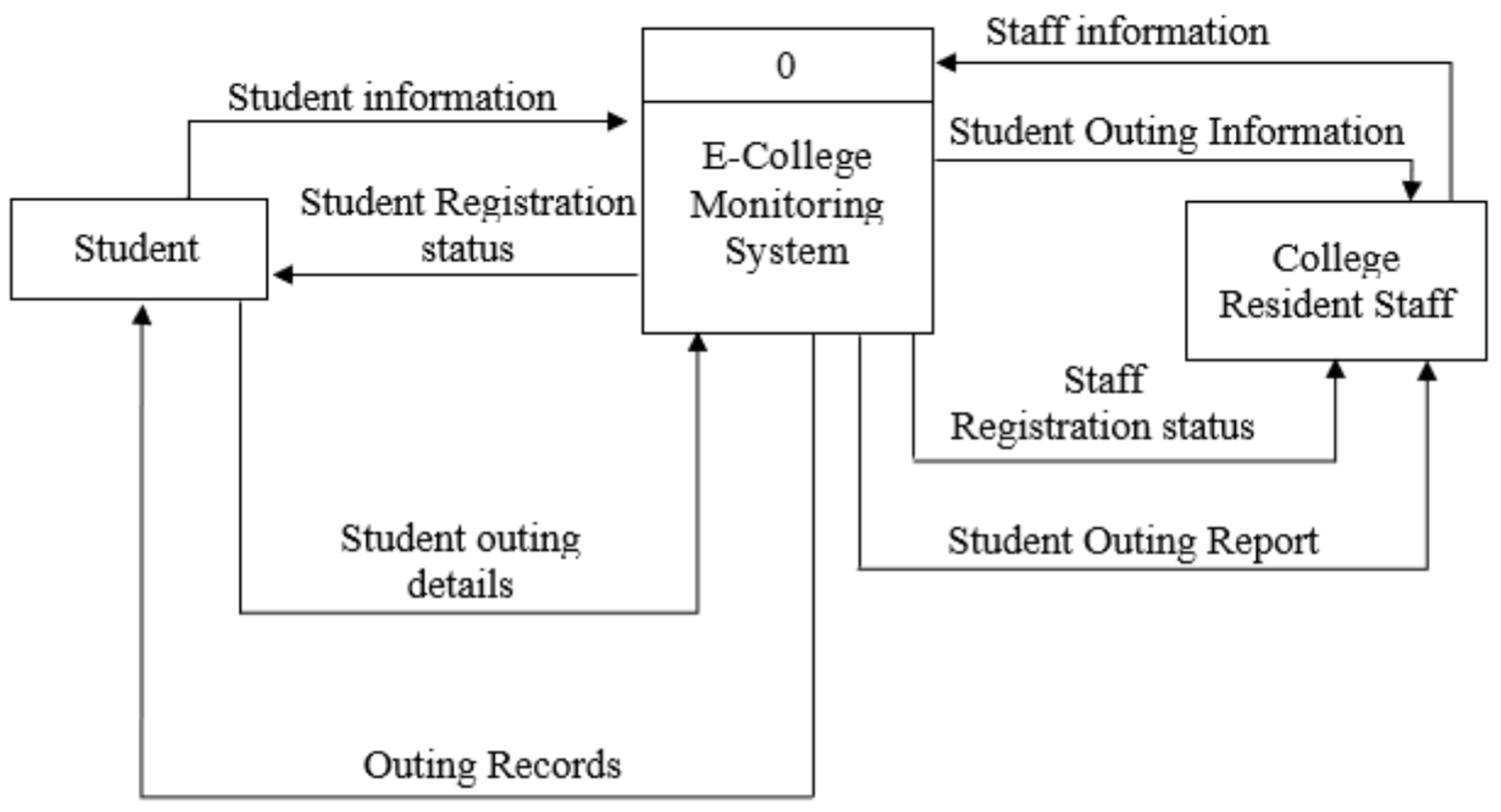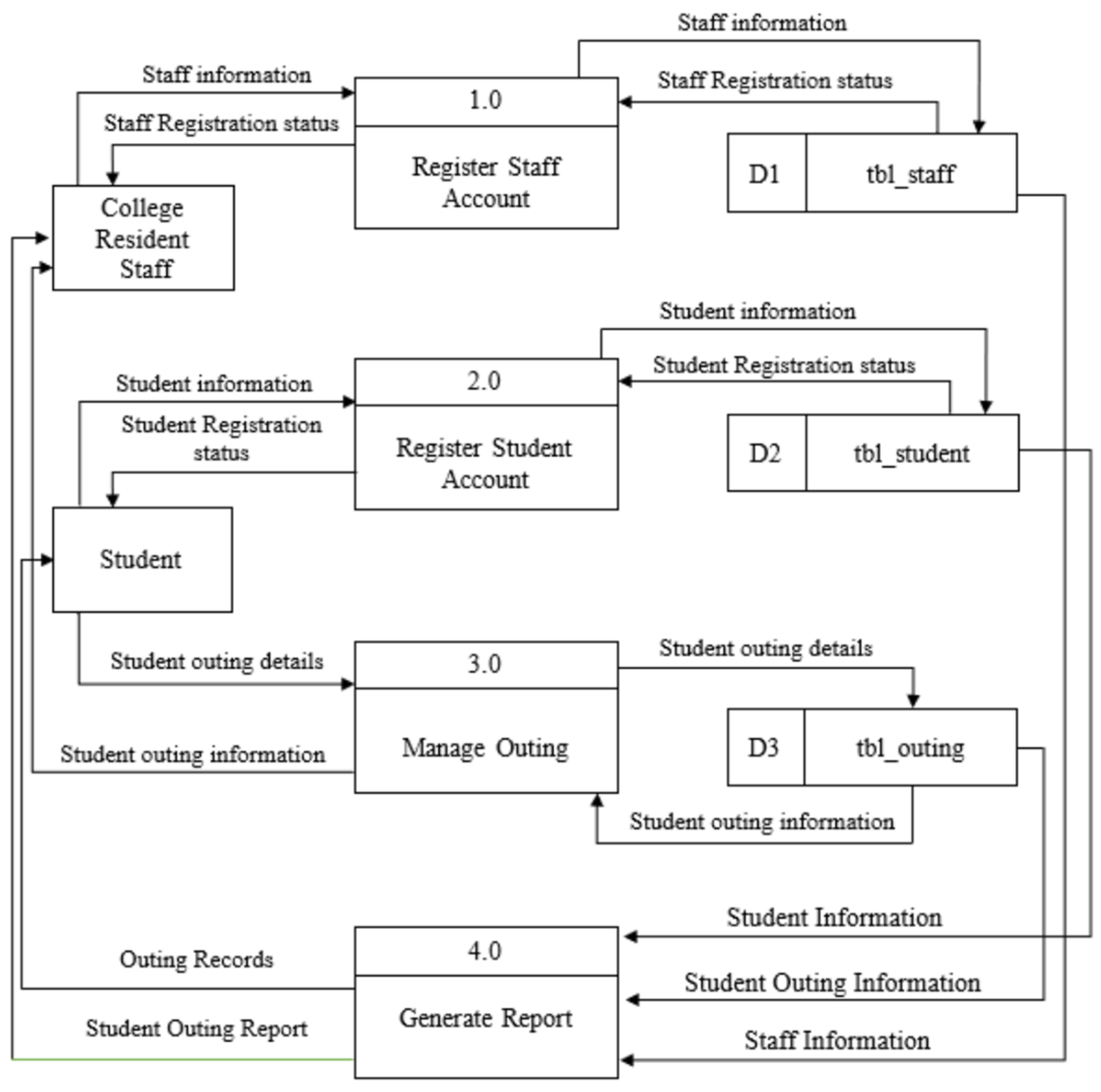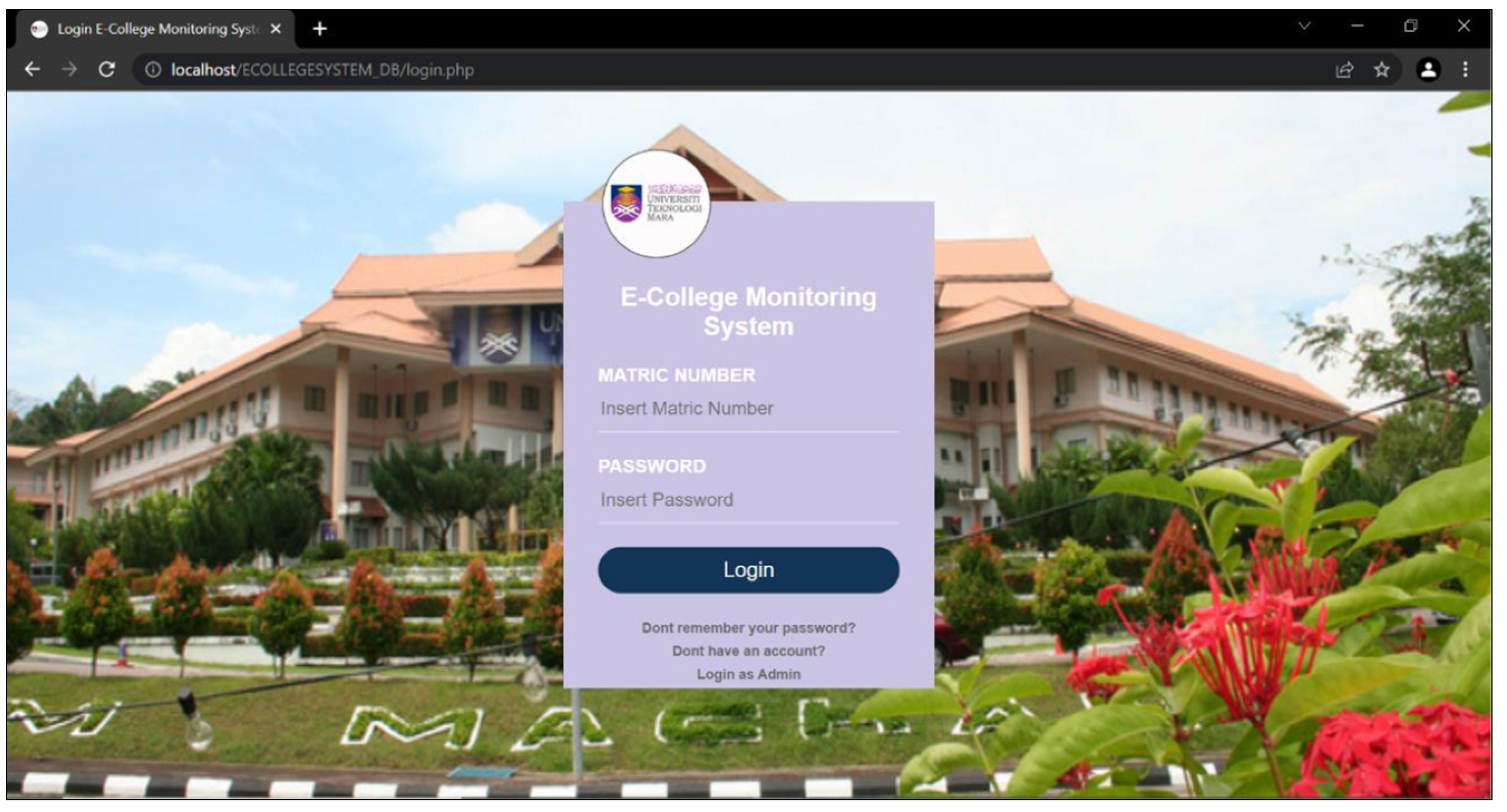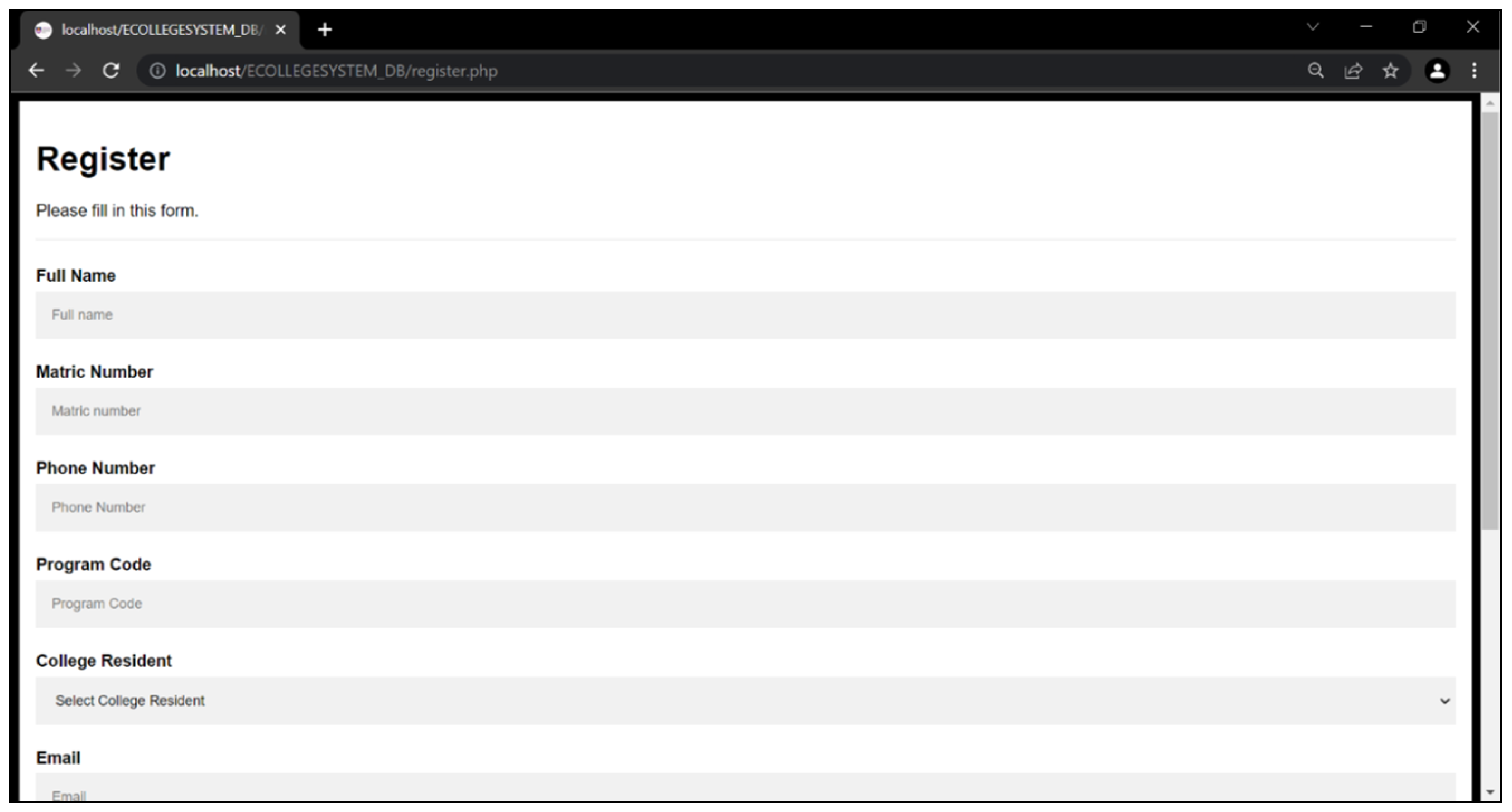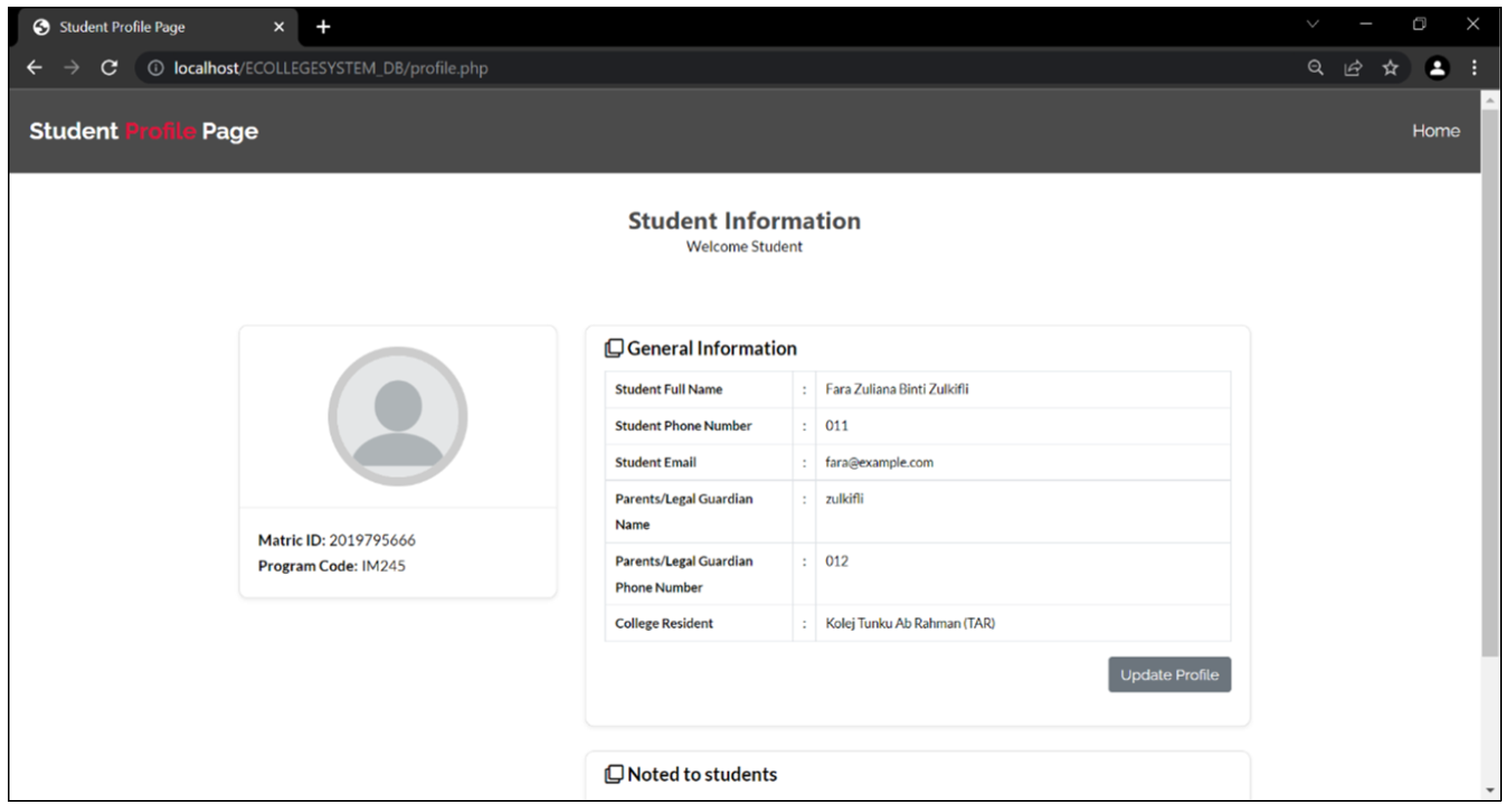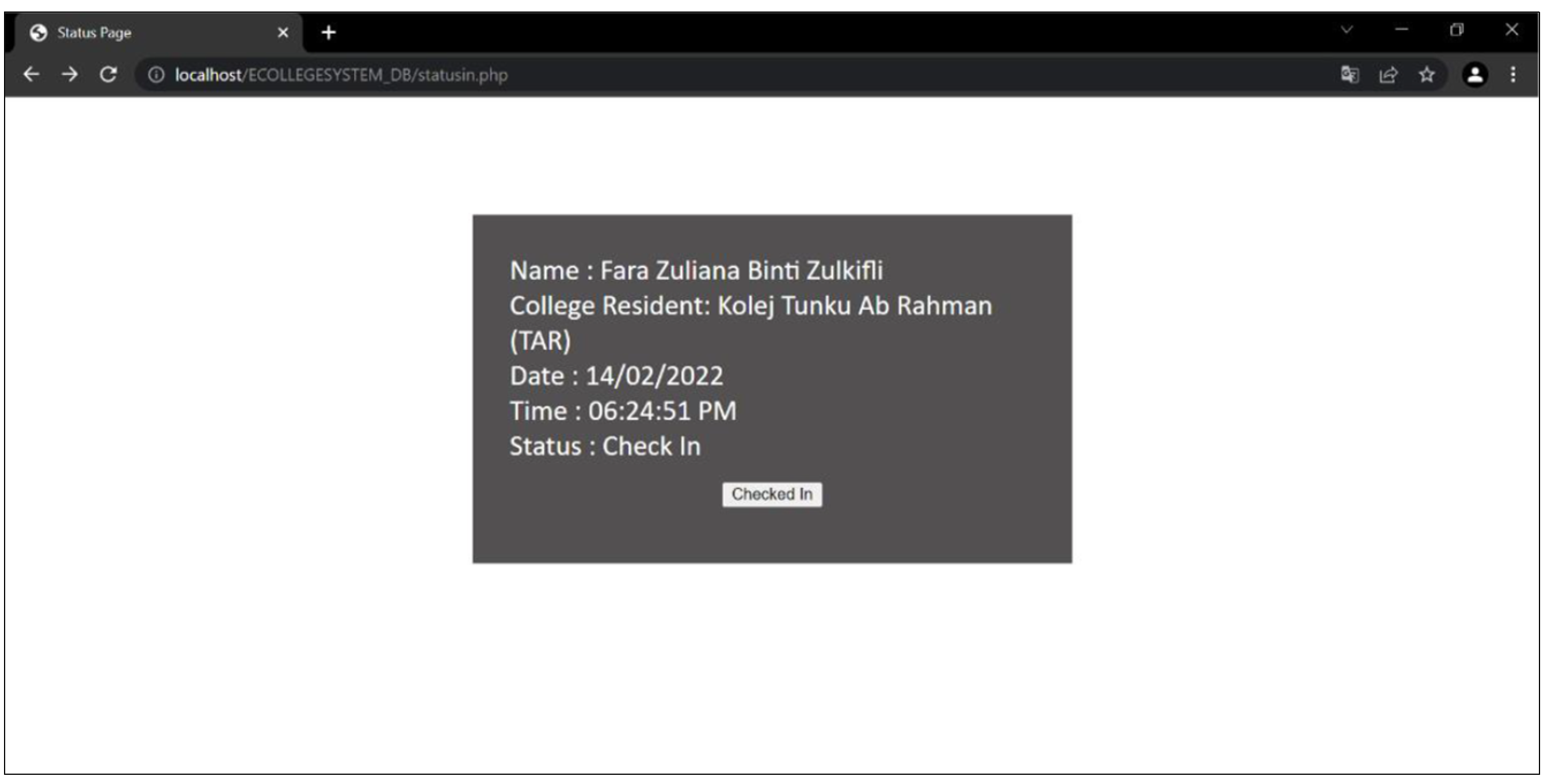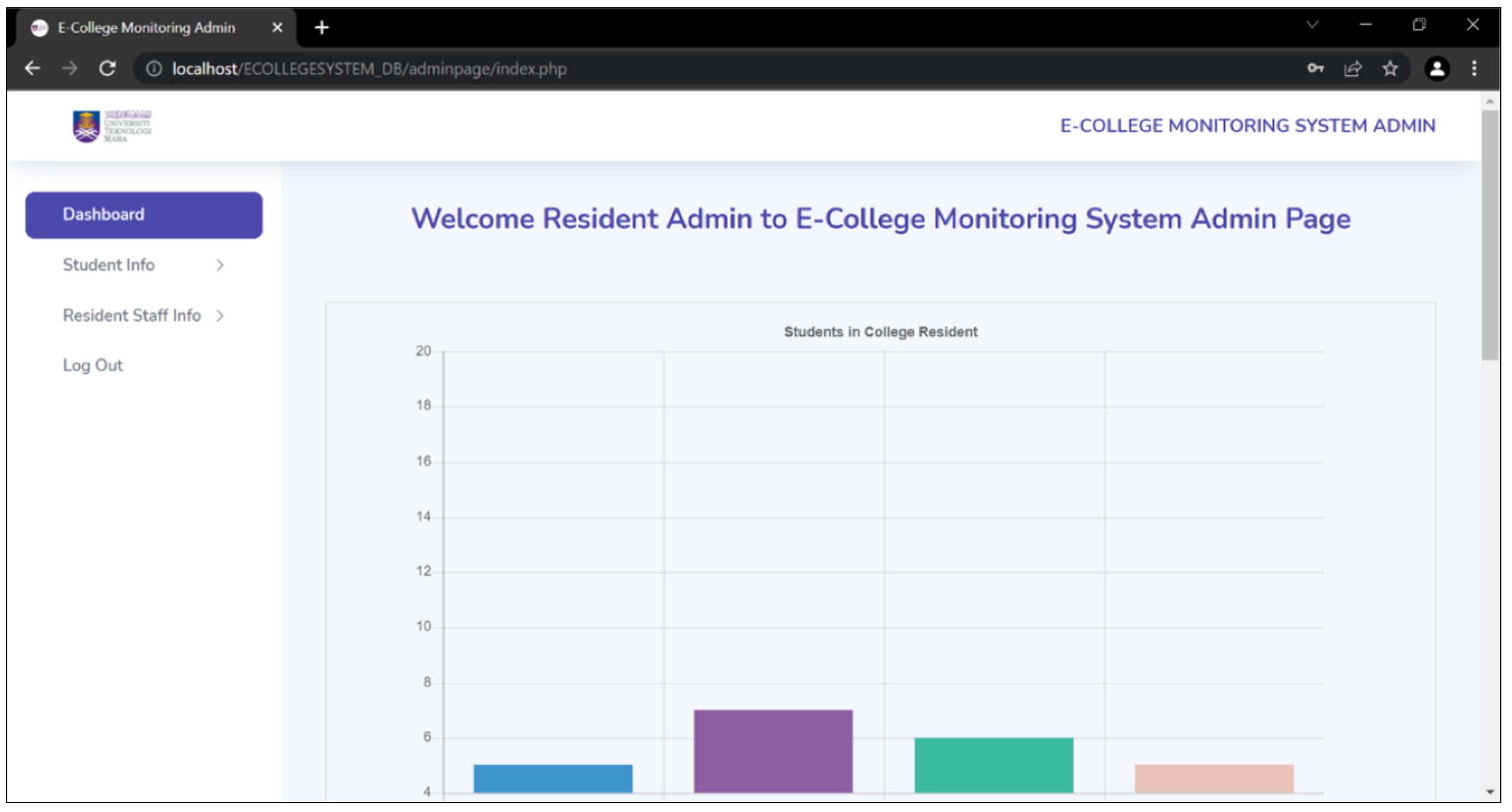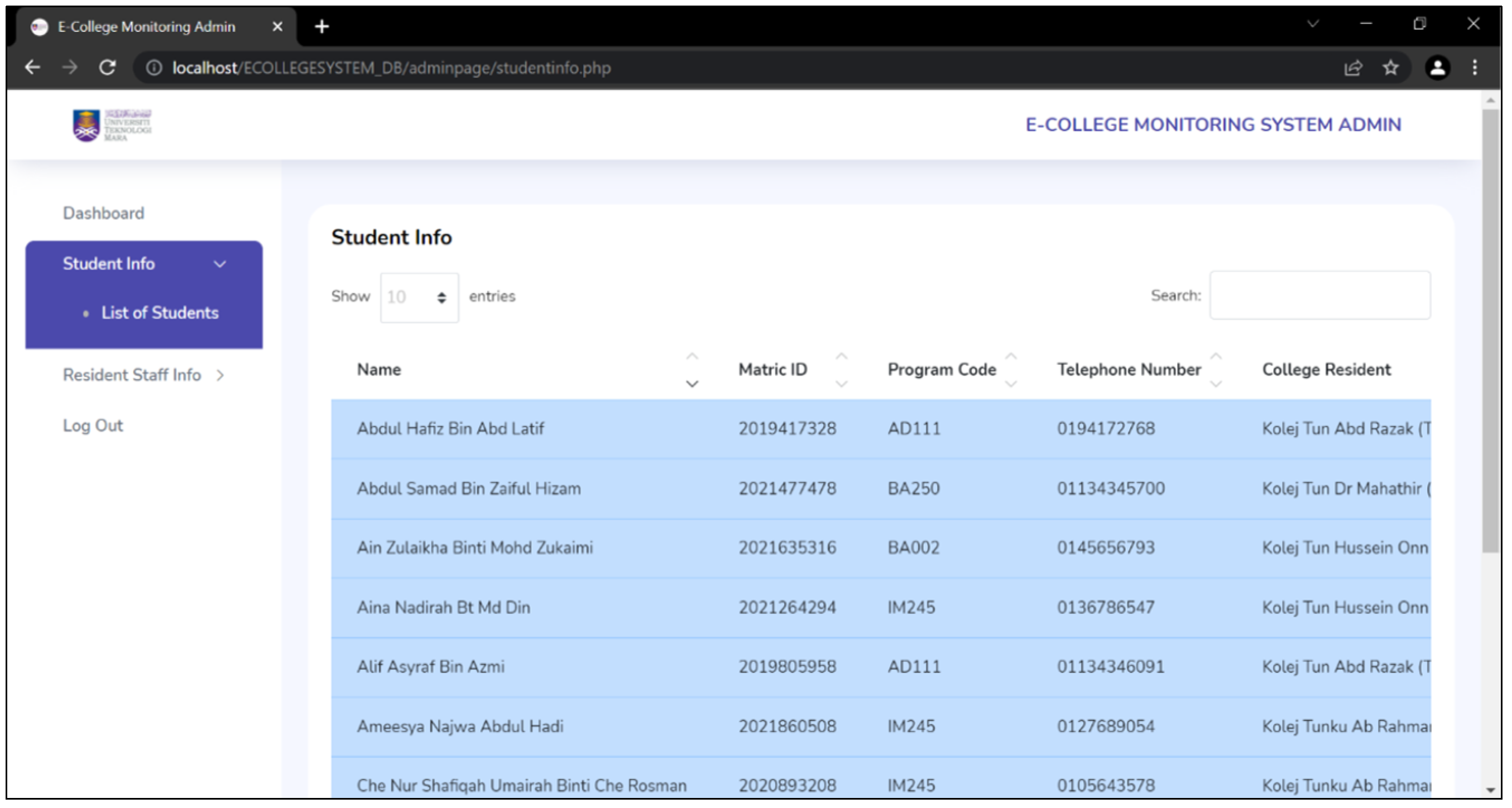1. Introduction
Every university will provide accommodation for students, especially those who are far from their homeland. UiTM Machang Kelantan agrees. The E-college Monitoring System, which was designed, makes it simpler for hostel or college residents to keep track of how many students are entering and exiting. This approach will benefit the University of Technology MARA (UiTM) Machang Campus hostel or college and many others.
The E-College Monitoring System is a method for UiTM college students to help with the problem of resident staff approval of outings. With this method, students will not need to ask the resident staff for permission. Compared to a manual method, the system makes it possible to track outing activities more effectively. Students who use the E-college Monitoring System must complete forms for their guardians or parents so that residents or staff can get in touch with them in an emergency. When a student scans their outing activity, the resident staff and the student’s parents are notified. The resident staff can also look over the report to see if any students failed to return to the dorm or college.
Residents can more easily keep track of where their students are using the E-College Monitoring System. It can also act as a reminder to students that they have until 11 p.m. to enter the UiTM property. There are thousands of students at UiTM, and it is challenging to keep track of them all, so using a manual system, like filling out a form, is a burden. Using the E-College Monitoring System, parents may keep an eye on their children without worrying about their whereabouts or other circumstances.
Tracking the whereabouts of the students is an important step in the hostel management process, as mentioned by [
1]. The authors indicate that a lot of data, including students’ in and out times, disciplinary issues, details about their parents or guardians, merits, and so on, must be kept when needed to conduct the outing system for students at every boarding school. In most public and private institutions nowadays, manual registration is employed to track students’ movements, and students are required to record every aspect of their activities in a log book. Other than that, in accordance with [
2], the creation of the smart outing and attendance system in this project as a suggested solution to the mentioned issues is anticipated to improve the safety and security of boarding school students.
2. Backgrounds of the Study
2.1. Problems Statements
According to certain views, some public and private institutions continue to use manual systems, such as the requirement that students carry their outing cards with them everywhere they go. The drawback of the manual system is that students must carry the card at all times, and if it is lost, they must purchase a new card, which can cost anywhere from MYR 5 to MYR 10 for one card. The student monitoring process is now carried out manually in UiTM Machang utilizing a paper-based system. They rely on manual procedures, such as coming to the office to ask the resident staff for permission to go on an outing, because they lack an E-College Monitoring Application System.
As a consequence, it will be challenging for the College Resident Staff (CRS) to keep track of the students who do not arrive on time and figure out how many students are currently absent. To find out the status of the students, the CRS must manually count the number of outing cards at the guardhouse. It consumes a lot of effort and work to complete this process. In addition, the possibility of data loss is particularly high, since data is stored in multiple files at one location. Due to the high number of students enrolled, it is possible that human mistakes will cause all of the manually kept data to be destroyed and that there is no backup data.
With the development of the technology and the advancement of the Internet, researchers decided to develop a web-based system that can be used to assist their management, especially the CSR in hostel management. According to [
3], in today’s environment, information systems are critically needed to change the manual paper-based work, which, at the same time, helps to improve the efficiency and optimize the time in delivering the maximum service. In line with this, a study by [
4] discussed that computerized information systems benefit people in many ways, especially in helping the organization to reduce the use of space to store data and the reduction of costs, which leads to efficient time management. The design of this web-based computer experiment management system was carried out within three aspects: overall design, database design, and function module design. The system design should be based on the principle of security, and different users should be able to validly acquire a corresponding authority [
5].
2.2. Objectives of the Systems Development
This system will work to improve the outing system for UiTM students. This system will take the place of the current manual system. Hence, the objectives of this system include:
OBJ 1: To identify appropriate data from the college administration;
OBJ 2: To organize the data gathered from the college administration;
OBJ 3: To develop a system that can manage the student’s outings at UiTM.
2.3. Scopes of the Systems Development
This system will work to improve the outing system for UiTM students. This system will take the place of the current manual system. The system will include a feature that allows parents to receive notifications through email. The resident staff, who is in charge of updating the student data, will provide the initial data gathering. The mobility of students is a major area, as is delivering reports (statistics) after each month. The initial data will be collected from the resident staff members who are in charge of updating the student information. The E-College Application System is a mobile application that caters to two types of users: residents and students. The system consists of three main modules.
The first module is the registration module. This module offers a conceptual framework for entering information about those students in a way that: facilitates data entry and accuracy by matching the entry to the data source, connects registers to data by easily tying back to individual student records, and gathers data elements to enable better student supervision. The second module of the system is the monitoring module. This module is used to monitor the location of the students. Through this module, the CRS can identify the students who are absent from the campus or college. The next module is the reporting module. This module involves the process of generating reports and statistics for the use of management.
3. Methodology
Referring to [
6], the E-College Monitoring System is developed following several empirical stages. First, we conduct a review of the existing forms, procedures, and reports. Second, interview sessions are conducted with the stakeholders, which are the College Resident Staff (CRS) and students. Finally, to have a structured process, the System Development Life Cycle (SDLC) is used as the methodology in developing the E-Outing System. The SDLC comprises five (5) stages, which include planning, analysis, design, implementation, and maintenance [
7].
Planning is the first stage of the SDLC. In an attempt to optimize a new system that is user-friendly and helps to streamline the monitoring process, we evaluated manual operations throughout the planning phase. The management’s policies and practices, as well as reports, are then analyzed during the analysis phase to fully understand the outing monitoring activity process. Based on a review of the present systems, we could determine the benefits and drawbacks of the current practices and could see the issue much more clearly [
8]. Additionally, we included any hardware and software that is best-suited for use in developing the E-College Monitoring System.
In the design phase, once the requirements are gathered and understood, a detailed design is constructed, and the hardware and software are identified. The design phase starts with the data flow of the system, which will describe more about the process of our system. Our system design is continued by designing and creating an Entity Relational Relationship Diagram (ERD) and Data Dictionary (Metadata) that will explain the structure of the database system that will be developed. Apart from that, in the design phase, the user interface is designed, which will act as a guideline in the development process and, at the same time, will help to endure that the system is user-friendly and easy to use [
9].
The next phase is the implementation stage. This implementation stage is about how the system will be used by the user and implement the function. This phase is essential to ensure that this system will be implemented correctly and efficiently on the device involved. Coding or programming is the main activity in this implementation process, and the most important thing is that it fulfills the users’ expectations and avoids critical errors in the program to ensure that the system runs effectively. Additionally, during this stage, the process of hardware and application installation occurred. Furthermore, the implementation phase is important to identify the system function, as well as to verify whether it works as expected and as documented in the requirements analysis phase. In this phase, the system is tested to ensure no bugs or errors.
After the product is fully operational, the SDLC’s maintenance phase begins. As stated by [
7], software maintenance might involve software upgrades, repairs, and software patches if the software breaks. In addition, as discussed by [
10], once the product or application is launched or officially in full operation, the maintenance phase of the SDLC occurs. The author of [
11] stated that the process of maintaining the software or application may include software upgrades, application repairs, and bug fixing. In this phase, some final alterations and bug fixing are done. Moreover, the system is also presented and trained for the users to ensure that the system is fully operational and developed according to their needs.
Figure 1 shows the context diagram of the E-College Monitoring System, where we can see the external entities in this system, which are a student and the College Resident Staff.
The figure specifies the system’s boundaries. It identifies the information flows between the system and the external entities. The E-College Monitoring System was developed for college students to assist them in keeping track of their time spent on and off the campus of UiTM. To log into the system, students must complete a form through the E-College Monitoring System. Once users have successfully registered with the system, they can use the system’s QR code scanning feature. The system will display the outing records. As for the College Resident Staff, they can log in with their staff IDs. A student’s scan results are reflected in the system, and their check-in and check-out times are immediately displayed.
In
Figure 2, the data flow diagram of the E-College Monitoring System identifies the flow of the information, which consists of inputs, outputs, data stores, and subprocesses. Students create an account with the E-College Monitoring System. Once the students successfully register with the system, their information will be stored and displayed. Students that scan their QR codes are likewise tracked by the E-College Monitoring System. The administrator then receives information about the students who scan QR codes when entering and exiting the UiTM campus. Finally, the system will generate a report for the administrator to keep track of how many students are entering and exiting the UiTM.
4. Main Interfaces of the E-College Monitoring System
The application was developed using PHP programming language, adopting the Laragon framework. The following figures show print screens of the user interfaces for the E-College Monitoring System. The following
Figure 3 illustrates the login page of the system.
Figure 4 shows the registration page of the system. Each user are required to register an account to use the system. Once the registration process is complete, users’ detail will be displayed as in
Figure 5.
The following
Figure 6 indicates students’ outing history. Students can view their outing history in this page. This page will display their in and our time. The check in and check out function is shown in
Figure 7. Through this module, staffs are able to monitor the students.
This system is not only beneficial and useful to the students but also to the management. Through this system, management can monitor the students as shown in
Figure 8. Apart from that, by using this e-College Monitoring System, the managements especially the College Residents Staff (CSR) can view the details of the students including their contact number as illustrated in
Figure 9.
5. Conclusions
The E-College Monitoring System will provide students and resident staff with numerous benefits. The usage of technology can help to strengthen and secure the systems. Through the installation of the new system, any issues that developed in the prior manual system will be fixed. When students embark on outings, the system will ensure that both the resident staff and students are aware. It will be a more efficient approach to keep track of the students’ information. The QR code scanner features in this system can track the student entering and leaving information with specific dates and times. Residents will be informed that the students will be absent from the UiTM premises on specific dates. This skill will aid in keeping staff up-to-date on the student data information from their history of outings information.
More services, such as a resident activity monitor, are also being added to strengthen the system. The parental activity monitor can assist in tracking the students going out or entering UiTM Machang. This feature will make the system more functional for all users participating in the application management.
When fully established and following a successful implementation at UiTM Machang, it is our hope and vision that the system will be adopted by other UiTM universities, along with other universities in Malaysia, whether public or private. As a result, the E-College Monitoring System may be a viable option for all students and resident staff. There will be significant cost savings, and student outing administration will be much more simplified.
Author Contributions
Conceptualization, N.A.M.M.N. and N.S.S.; methodology, S.A.M.G. and N.H.M.R.; validation, N.A.M.M.N.; formal analysis, F.Z.Z.; investigation, F.Z.Z., N.S.S. and F.M.M.; resources, S.A.M.G. and N.H.M.R.; software, F.Z.Z. and F.M.M.; writing—original draft preparation, N.A.M.M.N., N.S.S., S.A.M.G., N.H.M.R., F.Z.Z. and F.M.M.; writing—review and editing, N.A.M.M.N.; visualization, N.S.S.; supervision, N.A.M.M.N. and project administration, N.A.M.M.N. All authors have read and agreed to the published version of the manuscript.
Funding
This research received no external funding.
Institutional Review Board Statement
Not applicable.
Informed Consent Statement
Not applicable.
Data Availability Statement
Not applicable.
Acknowledgments
This research was partially supported by the Universiti Teknologi MARA Kelantan Branch, Malaysia.
Conflicts of Interest
The authors declare no conflict of interest.
References
- Mansor, M. Sistem Keluar Masuk Asrama Berkomputer Sek. Men. Sains Pokok Sena. Doctoral dissertation, Universiti Teknologi Petronas, Tronoh, Malaysia, 2003. [Google Scholar]
- Wen, M.K.K.; Ahmad, N.; Ruslan, S.H. Arduino based outing and attendance system for boarding school students. Indones. J. Electr. Eng. Comput. Sci. 2020, 20, 1053. [Google Scholar]
- Kuo, S.E.; Lai, H.S.; Hsu, J.M.; Yu, Y.C.; Zheng, D.Z.; Hou, T.W. A clinical nutritional information system with personalized nutrition assessment. Comput. Methods Programs Biomed. 2018, 155, 209–216. [Google Scholar] [CrossRef] [PubMed]
- Azza, A.M. An Empirical Study of MIS Impacts and Organizational Efforts on Improving Business Performance; Taylor & Francis Group: London, UK, 2017. [Google Scholar]
- Yu, J.; Xu, J. Design and Implementation of Warehouse Management System Based on Web Technology. In Proceedings of the 2018 3rd International Conference on Mechanical, Control and Computer Engineering (ICMCCE), Huhhot, China, 14–16 September 2018. [Google Scholar] [CrossRef]
- Rosman, M.R.M.; Abdullah, R.Y.R.; Salleh, M.I.M. Development of Vehicle Observation System as security mechanism towards electronic records conversion. In Proceedings of the 2010 International Conference on Science and Social Research (CSSR 2010), Kuala Lumpur, Malaysia, 5–7 December 2010; pp. 699–704. [Google Scholar]
- Hoffer, J.A.; George, J.; Valacich, J.S. Modern Systems Analysis and Design; Pearson: Boston, MA, USA, 2017. [Google Scholar]
- Chassiakos, A.P.; Sakellaropoulus, S.P. A Web-based System for managing Construction Information. Adv. Eng. Softw. 2008, 39, 865–876. [Google Scholar] [CrossRef]
- Taylor, M. A General Understanding of Microsoft Excel, Visual Studio, and WebMatrix. Available online: http://533507.weebly.com/notepad.html (accessed on 21 May 2022).
- Maintenance Phase in SDLC. Available online: https://study.com/academy/lesson/maintenance-phase-in-sdlc.html (accessed on 21 May 2022).
- Mohamad, S.M.S. Development and implementation of a web-based system to study children with malnutrition. Comput. Methods Programs Biomed. 2009, 93, 83–92. [Google Scholar] [CrossRef] [PubMed]
| Publisher’s Note: MDPI stays neutral with regard to jurisdictional claims in published maps and institutional affiliations. |
© 2022 by the authors. Licensee MDPI, Basel, Switzerland. This article is an open access article distributed under the terms and conditions of the Creative Commons Attribution (CC BY) license (https://creativecommons.org/licenses/by/4.0/).
